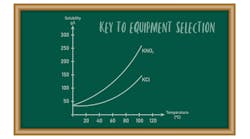Solids Processing: Get The Right Data In The Right Order
Solids processing is a unique technical field. Data on many important properties necessary to understand a flow problem, pressure change or product quality issue aren’t easy to determine. So, how do you go about solving a problem when you’re understaffed or don’t have access to laboratories that could obtain the data you need? One obvious and common approach is to call in a consultant — expecting that the person, through his or her infinite wisdom, can take one look at the problem and solve it. Don’t count on that. In fact, such swift resolution of an issue by a consultant rarely happens.
What a good consultant can do is help you define what data or research are required to point you in the right direction. It is money well spent. One warning: stress to the consultant that you have limited resources and the properties or studies recommended must be prioritized based on your current understanding of the problem. You can’t do a whole research project in a production environment.
However, before bringing in a consultant, you should get a handle on three major physical properties that almost always are required to understand a solids processing problem: moisture, particle size and solids loading.
Most plants can give you basic numbers for these properties. Realize, though, that these properties often aren’t a single number but rather a range of numbers.
Moisture. This varies through a batch and within the particles. We had a clumping problem with material that was stored for a period of time after drying. In this case, the important parameter was the critical moisture. The filtration unit after the crystallizer had a wet-cake moisture well above the critical moisture; however, it did vary over time. The research team had decided that a drying time of 30 minutes sufficed to reach the desired final product moisture. And, indeed, drying for that amount of time worked well for several years.
Filters do deteriorate over time and cloth material can vary in quality even when new. One day, the clumping problem cropped up due to an increase in wet-cake moisture. Raising the drying time caused clumping in the dryer and some product damage. The fine particles were dry but some of the larger particles were still just below the critical moisture. The problem was resolved by monitoring the solids temperature to ensure it was above the dew point in the dryer and using a fixed drying time from that point on. Because the critical moisture was reached, drying would occur in the falling-rate zone without overheating the solids. This process should have been designed with a control that varied the drying time to account for the constant-rate drying period that changed with the starting moisture.
Particle size and solids loading. As with moisture, particle size isn’t a single number but a range of values. Unfortunately, the range can change during processing due to attrition and agglomeration. To some extent, the particle size distribution’s effect on your process goes hand-in-hand with the solids loading. At low concentration, particles in a slurry or suspension behave as single particles in a fluid. As the concentration rises, they start to behave like larger particles and then settle faster. This can cause a fluid bed to collapse or a pneumatic conveyor to plug up.
Another thing to look at before you call in a consultant is your equipment arrangement. While I’ve seldom seen a piece of equipment that wasn’t doing what it was supposed to do, I’ve encountered many cases where equipment was overextended or used in the wrong order. For example, running a crystallizer to produce a large particle size to save filter time could result in a greater number of fine particles from the dryer. A better route may be to run the crystallizer to make smaller particles and then agglomerate these into larger particles in the dryer. To evaluate this option, you may need a filtration study to determine the optimum particle size at which you should run the crystallizer to prevent overloading the centrifuge.
So, save yourself some money. Before you call in a consultant, get the data mentioned above and look at the arrangement of your equipment. Analyzing these details may provide insights that enable you to solve the problem without the need for external help.


